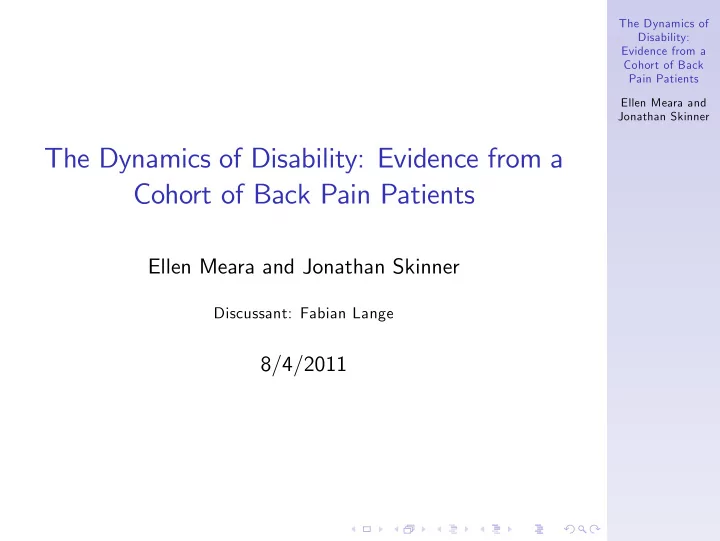

The Dynamics of Disability: Evidence from a Cohort of Back Pain Patients Ellen Meara and Jonathan Skinner The Dynamics of Disability: Evidence from a Cohort of Back Pain Patients Ellen Meara and Jonathan Skinner Discussant: Fabian Lange 8/4/2011
The Dynamics of The Incentives of SSDI Disability: Evidence from a Two views Cohort of Back Pain Patients Ellen Meara and Jonathan Skinner 1. Autor & Duggan (2003, 2006) emphasize the incentives on the work decision taking health as given. 2. Meara & Skinner (2011): SSDI has important implications for the incentives to maintain health. Is health endogenous or exogenous?
The Dynamics of Autor and Duggan (2006) Disability: Evidence from a Cohort of Back Pain Patients Ellen Meara and Jonathan Skinner Disability Insurance Awards by Diagnostic Group (per 1,000) 1983 2003 Musculosk. Disorder 0.48 1.33 Mental Disorder 0.39 1.38 All Others 2.07 2.54
The Dynamics of Autor and Duggan (2006) Disability: Evidence from a Cohort of Back Pain Patients Ellen Meara and Jonathan Skinner 1. 1984 reforms altered eligibility criteria away from verifiable diagnostic criteria towards "ability to function". 2. Subsequent to 1984, backpain and mental disorders drive growth in SSDI 2.1 Affect young workers 2.2 Low exit rates: chronic disease with low associated mortality rates. 3. Autor and Duggan (2006) emphasize increasing generosity of SSDI for low wage earners. 4. Health in the population itself is seen as exogenous.
The Dynamics of Meara and Skinner (2011): SSDI affects Disability: Evidence from a incentives for health investments Cohort of Back Pain Patients Ellen Meara and Jonathan Skinner 1. (Motive) Increased availability of SSDI lowers the incentives to maintain good health. 1.1 Over time: expect decline in health of SSDI applicants. 2. (Means) Behavioral Response to SSDI: 2.1 Occupational choice 2.2 Risky behaviors.
The Dynamics of Motive Disability: Evidence from a Cohort of Back Pain Patients Ellen Meara and Jonathan Skinner 1. Present value of DI award for average 50 year old DI awardee is $150K. Including value of health insurance this rises to $245K. (Autor and Duggan, 2006). 2. Replacement rates of up to 90% for lowest wage workers. 2.1 Benefits are partially indexed to average wages. 2.2 Slow wage growth for low wage earners means that replacement rates have increased for low wage workers.
The Dynamics of Means Disability: Evidence from a Cohort of Back Pain Patients Meara and Skinner (2011) emphasize the choice of Ellen Meara and Jonathan Skinner occupation and industry: 1. Synthetic Cohort evidence using NHIS (Case & Deaton, 2005): Individuals in manual occupations experience faster decline in health. 2. Fletcher and Sindelar (2009) use PSID to show that health declines faster among those whose first profession is in the blue collar sector 2.1 In OLS, even after controlling for initial health differences 2.2 Similar results when occupation choice is instrumented for using parental education and local occupation mix. 3. Risky behaviors - smoking, drinking, fatty foods.
The Dynamics of Circumstantial Evidence Disability: Evidence from a Cohort of Back 1. Has health of SSDI recipients improved since 1984? Pain Patients 1.1 No: neither in absolute terms or relative terms. Ellen Meara and Jonathan Skinner 1.2 Also not among least educated amongst whom SSDI receipt most prevalent. 2. Other evidence in the paper is more directly concerned with the dynamics of the health process. 2.1 Grossman (1972) vs. Case and Deaton (2005). 3. Hard to directly link any type of reform to observed changes in measured health: 3.1 Long lags between health investment and measured health. 3.2 Forward looking behavior. 4. Health behaviors directly: 4.1 Switching into manual / blue collar occupations since 1984? No. 4.2 Are less educated quitting smoking less rapidly or gaining weight more rapidly than the more educated? No. (Cutler, Lange, Meara, Richards, Ruhm, 2011).
The Dynamics of Policy Implications Disability: Evidence from a Cohort of Back Pain Patients Ellen Meara and Jonathan Skinner 1. The question is much larger than SSDI and cuts across all large social programs: 1.1 SSDI subsidizes bad health. 1.2 Medicare/Medicaid subsidizes goods consumed when in bad health. 1.3 On the other hand, Social Security subsidizes good health / longevity. 2. Dynamic, long-run effects of 1984 reform on enrolment exceed short run / static response.
The Dynamics of Experience Rating? Disability: Evidence from a Cohort of Back Pain Patients Ellen Meara and Jonathan Skinner 1. Should we introduce experience rating analogous to UI? 1.1 probably not at the firm level. 1.2 maybe at the occupation or industry level? 2. Almost surely regressive. 3. Netherlands have introduced experience rating for disability insurance.
The Dynamics of In Summary Disability: Evidence from a Cohort of Back Pain Patients Ellen Meara and Jonathan Skinner 1. Endogenous health responses? 1.1 There are means and motive, so I would be inclined to suspect the crime. 1.2 Little in the form of direct evidence. 1.3 So the jury is still out. 2. If the endogenous responses are large, then the consequences cut across all social programs. 3. The contribution of this paper is to put this question back into play in the context of SSDI.
Recommend
More recommend